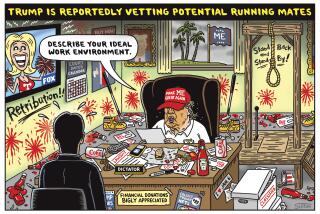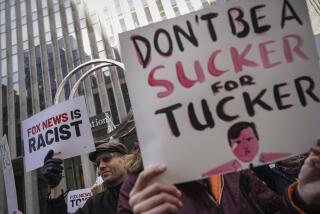Red-blue distinctions evoke personalities as much as politics
Is America’s red-blue divide more about politics or more about sociology?
Today’s cartoon is the second half of a large cartoon that helped me win the Pulitzer Prize for editorial cartooning in 2003. In this part, as in Part 1 that ran in Top of the Ticket last Friday, the vignettes do not deal with the candidates for whom these red staters and blue staters vote, rather they caricature how those people think and feel and get along in the world.
There are the small-town folks, raised in a more homogenized, placid environment, who feel a bit bewildered and threatened by the cacophony and weird characters that come at them on a big-city street. In contrast, there is the urban gay couple nervously walking into a small-town cafe where it feels like every unfriendly eye is on them.
There are the obsessive recyclers with multiple bins in deep blue places like Seattle and there are the thrifty reusers with their cars on the lawn in deep red rural Alabama.
There are the sophisticated film buffs in San Francisco and Boston who prefer going to tiny theaters to watch movies with French or Italian dialogue. And there are the stressed parents in Oklahoma City and Jacksonville who worry about what their kids will hear and see at the multiplex.
There are the Americans who think a sports field is a place where kids should learn to be tough, fight to win and understand what it feels like to lose. And there are those who think competition needs to be tempered, that every child should have a positive, affirming experience because, by golly, every kid is a winner.
These attitudes are not absolute or all-defining. For instance, Barack Obama likes nothing better than a sharp-elbowed basketball game where he is out to crush his opponent. And, for all we know, Ted Cruz separates his paper and plastic, has a compost pile and is a secret fan of Bernardo Bertolucci. Still, it is a fact that the folks who do political research can very accurately predict which candidate a person will vote for based on where that person lives, the kind of car that person drives and what that person reads, eats or watches on TV.
The more marketing and media have made us aware of where we fit into the red-blue spectrum, the more we tend to congregate with people who share our lifestyle and beliefs. This is not just a case of choosing to go to one church over another; Americans are actually uprooting themselves and moving to places that feel more sociologically comfortable. This means Republican congressional districts are getting more Republican and Democratic districts are getting more Democratic. (Gerrymandering has intensified this trend, but statistics show personal choices are the prime engine of the phenomenon.)
We were better off as a country when the lines were more blurred, when political parties were less ideologically pure, when everybody read the same newspapers and watched the same TV news shows. There have always been huge distinctions between us, but, when it came down to it, as in the foxholes of World War II, we were all Americans.
Putting a qualifier in front of that identity — red or blue — is not what George Washington and all those smart guys back in 1776 had in mind, but it seems to be where we have landed, in spite of our best intentions and because of our all-too-human biases and fears.
More to Read
A cure for the common opinion
Get thought-provoking perspectives with our weekly newsletter.
You may occasionally receive promotional content from the Los Angeles Times.







